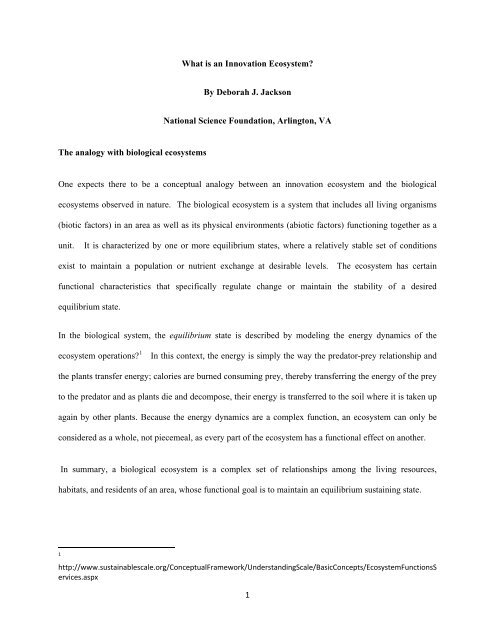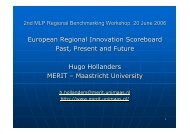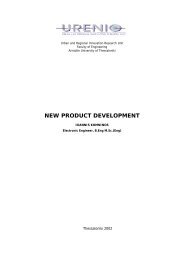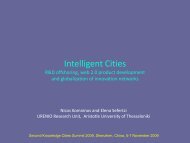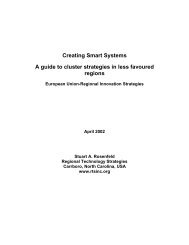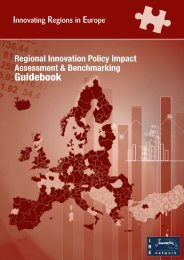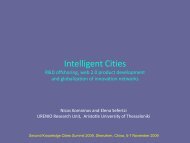What is an Innovation Ecosystem? By Deborah J. Jackson ... - Urenio
What is an Innovation Ecosystem? By Deborah J. Jackson ... - Urenio
What is an Innovation Ecosystem? By Deborah J. Jackson ... - Urenio
You also want an ePaper? Increase the reach of your titles
YUMPU automatically turns print PDFs into web optimized ePapers that Google loves.
<strong>What</strong> <strong>is</strong> <strong>an</strong> <strong>Innovation</strong> <strong>Ecosystem</strong>?<strong>By</strong> <strong>Deborah</strong> J. <strong>Jackson</strong>National Science Foundation, Arlington, VAThe <strong>an</strong>alogy with biological ecosystemsOne expects there to be a conceptual <strong>an</strong>alogy between <strong>an</strong> innovation ecosystem <strong>an</strong>d the biologicalecosystems observed in nature. The biological ecosystem <strong>is</strong> a system that includes all living org<strong>an</strong><strong>is</strong>ms(biotic factors) in <strong>an</strong> area as well as its physical environments (abiotic factors) functioning together as aunit. It <strong>is</strong> characterized by one or more equilibrium states, where a relatively stable set of conditionsex<strong>is</strong>t to maintain a population or nutrient exch<strong>an</strong>ge at desirable levels. The ecosystem has certainfunctional character<strong>is</strong>tics that specifically regulate ch<strong>an</strong>ge or maintain the stability of a desiredequilibrium state.In the biological system, the equilibrium state <strong>is</strong> described by modeling the energy dynamics of theecosystem operations? 1In th<strong>is</strong> context, the energy <strong>is</strong> simply the way the predator-prey relationship <strong>an</strong>dthe pl<strong>an</strong>ts tr<strong>an</strong>sfer energy; calories are burned consuming prey, thereby tr<strong>an</strong>sferring the energy of the preyto the predator <strong>an</strong>d as pl<strong>an</strong>ts die <strong>an</strong>d decompose, their energy <strong>is</strong> tr<strong>an</strong>sferred to the soil where it <strong>is</strong> taken upagain by other pl<strong>an</strong>ts. Because the energy dynamics are a complex function, <strong>an</strong> ecosystem c<strong>an</strong> only beconsidered as a whole, not piecemeal, as every part of the ecosystem has a functional effect on <strong>an</strong>other.In summary, a biological ecosystem <strong>is</strong> a complex set of relationships among the living resources,habitats, <strong>an</strong>d residents of <strong>an</strong> area, whose functional goal <strong>is</strong> to maintain <strong>an</strong> equilibrium sustaining state.1http://www.sustainablescale.org/ConceptualFramework/Underst<strong>an</strong>dingScale/BasicConcepts/<strong>Ecosystem</strong>FunctionsServices.aspx1
engineering systems <strong>an</strong>d then fosters the development of innovation ecosystems centered on theengineered system’s technologies. Th<strong>is</strong> program, which originated more th<strong>an</strong> 25 years ago within theNSF’s Engineering Directorate, has been very effective at initiating <strong>an</strong>d maturing ecosystems that arestable enough for the ERCs to continue operating after the initial NSF funding terminates after 10 years.Currently, 82% of the graduated ERCs continue to embody the primary character<strong>is</strong>tics of <strong>an</strong> ERC (i.e. theintegration of research, education, <strong>an</strong>d industry as <strong>an</strong> org<strong>an</strong>izing principle <strong>an</strong>d the mainten<strong>an</strong>ce of <strong>an</strong>engineered systems focus). 8An innovation ecosystem <strong>is</strong> said to be thriving <strong>an</strong>d healthy when the resources invested in the researcheconomy (either through private, government, or direct business investment) are subsequently replen<strong>is</strong>hedby innovation induced profit increases in the commercial economy.At that point, the two economies(research <strong>an</strong>d commercial) ex<strong>is</strong>t in bal<strong>an</strong>ced equilibrium <strong>an</strong>d the innovation ecosystem <strong>is</strong> deemed to behealthy.Th<strong>is</strong> <strong>is</strong> expressed by the following equation, & ∆ 1 ∆, (1)where <strong>is</strong> defined as the initial profit before the investments in fundamental research are made, <strong>is</strong>defined as profits corrected for investment, & 1 , & , <strong>is</strong> defined as thecommercial economy’s research investment in the research economy, <strong>an</strong>d ∆ <strong>is</strong> the innovation inducedgrowth in the economy. Thus a small amount of the profit, fundamental research. The result <strong>is</strong> a feedback loop, known as the virtuous cycle, which <strong>is</strong> depicted inFigure 1.&, <strong>is</strong> reinvested in order to fin<strong>an</strong>ce8 James E. Williams, Jr. <strong>an</strong>d Courtl<strong>an</strong>d S. Lew<strong>is</strong>, Post Graduation Status of National Science Foundation EngineeringResearch Centers: Report of a Survey of Graduated ERCs, Prepared for the National Science Foundation by SciTechCommunications LLC, J<strong>an</strong>uary 2010.4
CapabilitiesFundamentalTechnologyBreakthroughsR&D ResourceInvestmentsNew Products ,Features, or ProcessesIncreased Sales<strong>an</strong>d ProfitsNeedsResearch EconomyCommercial EconomyFigure 1. Virtuous cycle depicting how R&D resource investments are replen<strong>is</strong>hed through increasedprofits in the commercial economy in a thriving innovation ecosystem.When the innovation induced growth in profits exceeds the initial R&D investment, instead of beingbal<strong>an</strong>ced, the innovation ecosystem <strong>is</strong> said to be growing. Clearly the goal of most of today’s governmententities that fund innovation <strong>is</strong> to put their economies into a growth phase with increasing taxableearnings: & ∆ 1 ∆ . (2)<strong>Innovation</strong> spectrumThe challenge to creating growth in <strong>an</strong> innovation ecosystem <strong>is</strong> figuring out how to turn thebreakthroughs of R&D efforts into products that lead to profits. Achieving th<strong>is</strong> goal <strong>is</strong> complicated by thefact that the two economies operate on different reward systems, thereby making it challenging to link5
d<strong>is</strong>coveries derived from fundamental research with innovative products that c<strong>an</strong> tr<strong>an</strong>slate into profits inthe market place.Another challenge <strong>is</strong> the scarcity of implementation resources, , for technology demonstration <strong>an</strong>ddevelopment. In Figure 2, the innovation spectrum shows the d<strong>is</strong>tribution of resources invested inactivities aimed at d<strong>is</strong>covery, technology demonstration, technology development, <strong>an</strong>dcommercialization. At the far left of the spectrum (i.e. where academic research <strong>is</strong> concentrated), there <strong>is</strong>a heavy concentration of government investment in fundamental research; while to the far right of thespectrum (i.e. in the commercial marketplace) there <strong>is</strong> a much higher level of industry investment in directproduct development. Th<strong>is</strong> gap in resources for technology demonstration <strong>an</strong>d development (TD&D) <strong>is</strong>colloquially known as the Valley of Death. The actors engaged in moving innovations from d<strong>is</strong>coverythrough commercialization are academia, small businesses, the investor community, <strong>an</strong>d commercial&industry.For these actors, it <strong>is</strong> within th<strong>is</strong> valley that m<strong>an</strong>y potential innovations die for lack of theresources to develop them to a stage where industry or the investor community c<strong>an</strong> recognize theircommercial potential <strong>an</strong>d assess the r<strong>is</strong>k associated with bringing them to market.One might naively assume that the most effective way of helping the ecosystem to thrive <strong>is</strong> bysubst<strong>an</strong>tially increasing TD&D resources available in the Valley of Death. Though th<strong>is</strong> may successfullymove more innovations into the commercial sphere, it doesn’t guar<strong>an</strong>tee a thriving innovation ecosystembecause the assumption fails to account for resource limitations <strong>an</strong>d other uncertainties that could limitgrowth <strong>an</strong>d profits in the marketplace. To properly account for these uncertainties, a better underst<strong>an</strong>dingof the difficult-to-model economic dynamics within the ecosystem <strong>is</strong> needed. However, when the system<strong>is</strong> required to sat<strong>is</strong>fy the constraints of the virtuous cycle, a simple resource projection of the modelreveals that the effect of increasing the TD&D investments further reduces the ecosystem’s aggregatedprofits, thereby requiring a larger innovation induced profit, ∆, to complete the virtuous cycle as inequation 3,6
1 & ∆. (3)To make things worse, 99.9% of the TD&D enterpr<strong>is</strong>es presented to investors fail 9 , which me<strong>an</strong>s thatthe magnitude of the losses from the failed TD&D investments, &, in equation 3 c<strong>an</strong> be signific<strong>an</strong>t.The high loss rate c<strong>an</strong> be mitigated by teaming with professionals experienced in tr<strong>an</strong>slating technologiesacross the gap such as successful entrepreneurs, <strong>an</strong>gel investors, or venture capital<strong>is</strong>ts. But even with theextensive resources <strong>an</strong>d thorough due diligence practices of venture capital<strong>is</strong>ts, only one out of every 10of venture capital<strong>is</strong>t investments are considered to be commercial successes 10 . The reason that venturecapital<strong>is</strong>ts c<strong>an</strong>not guar<strong>an</strong>tee the success of the innovation enterpr<strong>is</strong>es they select <strong>is</strong> because there are m<strong>an</strong>yuncontrollable factors in the marketplace that cause enterpr<strong>is</strong>es to fail. Common reasons 11 for failure arem<strong>is</strong>judging the marketplace, government created roadblocks in approval (FDA, FCC, FAA, etc.), nomarket for the product; stronger competition th<strong>an</strong> expected; technologies that do not work as expected;bad m<strong>an</strong>agement dec<strong>is</strong>ions; bad luck; the required funding outgrowing possible fin<strong>an</strong>cial rewards;unexpected government ch<strong>an</strong>ges to laws or regulations, etc.9 Jeffry A. Timmons, Andrew Zacharak<strong>is</strong>, <strong>an</strong>d Stephen Spinelli, Business Pl<strong>an</strong>s that Work, McGraw Hill Comp<strong>an</strong>ies,2004, p. 1710 http://ezinearticles.com/?Improve‐Venture‐Capital‐Returns‐With‐IP‐Portfolio‐M<strong>an</strong>agement&id=142003911 http://www.questia.com/googleScholar.qst?docId=50012854567
FundamentalTechnologyBreakthroughsR&D ResourceInvestmentsNew Products ,Features, or ProcessesResearch EconomyIncreased Sales<strong>an</strong>d ProfitsCommercial EconomyIndustryResourcesGovernmentAcademiaIndustry, Investors,<strong>an</strong>d 6.3 GovernmentInvestmentInvestorsInventingSmall BusinessCommercializingD<strong>is</strong>covery TechnologyDevelopment CommercializationDemonstrationLevel of DevelopmentFigure 2. Th<strong>is</strong> figure links the innovation Spectrum to the two economies in the virtuous cycle; therebyillustrating the projection, along the different development stages, of the available resources within <strong>an</strong>ecosystem for d<strong>is</strong>covery, technology development, <strong>an</strong>d commercializationStat<strong>is</strong>tically, 50% of the venture capital<strong>is</strong>ts investment portfolios fail outright, 30% are marginal in thatthey don’t fail, but also don’t experience growth, 10% grow at a rate of about twenty percent a year, <strong>an</strong>d8
10% grow fast enough to provide returns in excess of 1000%. Venture capital<strong>is</strong>ts only classify <strong>an</strong>investment enterpr<strong>is</strong>e as successful if its return on investment (ROI) exceeds a factor of 10. The reasonventure capital<strong>is</strong>ts require a minimum ten-fold ROI <strong>is</strong> to ensure that they c<strong>an</strong> recover their investments onthe other nine investments that “fail”. Like the venture capital<strong>is</strong>ts, the innovation ecosystem mustexperience enough earnings growth to recover all investments in the TD&D to be considered healthy <strong>an</strong>dthriving.The high r<strong>is</strong>k to investors leads to several import<strong>an</strong>t conclusions about healthy conditions that defineinnovation ecosystems. First, the increased productivity from successful enterpr<strong>is</strong>es must be profitableenough to compensate for the monetary investment in fundamental research <strong>an</strong>d for the aggregatedinvestment in both the successful <strong>an</strong>d the failed TD&D ventures. Because there <strong>is</strong> a high probability mostenterpr<strong>is</strong>es launched in the ecosystem will fail, a healthy ecosystem should also be structured to h<strong>an</strong>dlefailures in a way that encourages terminating losing investments early in order to facilitate more efficientutilization of ecosystem resources. Ideally, the ecosystem <strong>is</strong> structured to efficiently recover <strong>an</strong>d recycle<strong>an</strong>y resources (including hum<strong>an</strong> capital) that are released upon the failure of individual enterpr<strong>is</strong>es.Because resources within the ecosystem are limited, the dynamics of success <strong>an</strong>d failure within the Valleyof Death represents <strong>an</strong> import<strong>an</strong>t mech<strong>an</strong><strong>is</strong>m for regulating the consumption of the ecosystem’s resources.Nurturing the culture of the innovation ecosystemIn the context of nurturing the culture of the innovation ecosystem, successful enterpr<strong>is</strong>es are consideredto be those that are self-sustaining. Given that st<strong>an</strong>dard, the above stat<strong>is</strong>tics on venture capital<strong>is</strong>ts successrates suggests that at least 50% of the venture capital<strong>is</strong>t investments in a technology arena become viableenough to contribute to the ecosystem’s culture by helping to create jobs, helping to shape thecompetitive environment, <strong>an</strong>d through participation in the ecosystem’s ideation <strong>an</strong>d innovation dialogs.Besides assembling the actors who will contribute to the innovation ecosystem, a healthy ecosystem alsoprovides a mech<strong>an</strong><strong>is</strong>m for building relationships <strong>an</strong>d other int<strong>an</strong>gibles between the actors <strong>an</strong>d entities. It9
<strong>is</strong> the development of these relationships that help facilitate deals when the need ar<strong>is</strong>es. In addition,finding ways to quickly identify <strong>an</strong>d root-out failing ventures while simult<strong>an</strong>eously accelerating thepassage of winning ventures through the Valley of Death facilitates the efficiency <strong>an</strong>d sustainability ofthe innovation economy.Turning Valley of Death into a Challenge Basin<strong>What</strong> are some of the int<strong>an</strong>gible ways of enh<strong>an</strong>cing the odds that emerging technology innovations willsuccessfully bridge the Valley of Death? There <strong>is</strong> no set recipe for developing relationships within <strong>an</strong>ecosystem because it depends on the specifics of the technology, the cultures of the ecosystem entities,<strong>an</strong>d the personalities of the players. The best way to describe how to approach the development of theserelationships <strong>is</strong> to start by viewing the “valley” in a metaphorical sense (see Figure 3). In th<strong>is</strong> context, theint<strong>an</strong>gible relationships of the innovation ecosystem compr<strong>is</strong>e everything one does to the infrastructure toeffectively move the research side of the valley wall further to the right; or to move the commercial sideof the valley wall further to the left thereby improving the odds of <strong>an</strong> innovative venture successfullysp<strong>an</strong>s the Valley of Death. For example, training a cadre of champions to shepherd ventures towardcommercial success represents a technology push that effectively moves the valley wall to the right.10
Figure 3. The innovation ecosystem cons<strong>is</strong>ts of the actors, entities, <strong>an</strong>d int<strong>an</strong>gibles. The int<strong>an</strong>gibles arethe complex relationships that effectively move the valley walls inward <strong>an</strong>d the valley floor upward inorder to replace the deep walled Valley of Death with the gentle slope of a challenge basin.Ideally, healthy ecosystems that have made such hum<strong>an</strong> capital investments also find ways to keep theirchampions engaged <strong>an</strong>d circulating within the innovation ecosystem by providing a me<strong>an</strong>s of subs<strong>is</strong>tenceor other incentives for them to elect to stay within the ecosystem. For example, ecosystems benefit fromthe by actively engaging the marginal <strong>an</strong>d moderate growth enterpr<strong>is</strong>es that are considered to be failuresby venture capital<strong>is</strong>t st<strong>an</strong>dards because they don’t produce large enough profits. In contrast, within theinnovation ecosystem, these enterpr<strong>is</strong>es bring value because (i) they have sustainable cash flows thatdon’t impact the to they c<strong>an</strong> serve as habitats for champions between enterpr<strong>is</strong>e ventures. It <strong>is</strong> a commonw<strong>is</strong>dom in the circles of investors that the experience of failure <strong>is</strong> just as valuable on the resumes ofchampions as the experience of success. Indeed, some have argued that the experience of failure <strong>is</strong> morevaluable, because it teaches the champions when best to cut their losses. Thus even failed enterpr<strong>is</strong>esbring valuable lessons <strong>an</strong>d experience into the culture of the ecosystem.An effective strategy for moving the commercial side of the valley wall further to the left would be to findways of lowering the perceived r<strong>is</strong>k for investors. For example, ecosystems that find ways to tr<strong>an</strong>slateknowledge of d<strong>is</strong>coveries developed in the research community into a context that <strong>is</strong> relev<strong>an</strong>t to theindustry investors reduce the perceived r<strong>is</strong>k for the investor so that he/she might be inclined to invest inthe technology at <strong>an</strong> earlier stage. Another approach would be for the researchers to find ways toestabl<strong>is</strong>h regular brainstorming dialogs with members of the investor communities about nascenttechnology <strong>an</strong>d it potential capabilities thereby leveraging the industry <strong>an</strong>d investor community’s firsth<strong>an</strong>dknowledge of the market sectors <strong>an</strong>d the unfilled needs that a nascent technology might potentiallyaddress.11
Beyond the int<strong>an</strong>gibles, there are infrastructure investments that are designed to benefit the innovationecosystem as a whole which c<strong>an</strong> reduce the negative impact of failures on the virtuous cycle’s feedbackloop. For example, putting in place rapid prototyping infrastructure <strong>is</strong> beneficial to the innovationecosystem because it (i) lowers the entry costs for start-ups to engage in innovation <strong>an</strong>d (ii) it ra<strong>is</strong>es thesuccess rate by increasing the number of attempts at tr<strong>an</strong>slating the Valley of Death. It <strong>is</strong> the type ofinvestment that government entities may be more willing to make because it spreads their r<strong>is</strong>k among alarger number of ventures, thereby increasing the ch<strong>an</strong>ces that they will have invested in <strong>an</strong> enterpr<strong>is</strong>egenerates more revenue <strong>an</strong>d creates jobs. The best examples of th<strong>is</strong> are the Semiconductor ResearchCorporation (SRC) for integrated electronics 12 <strong>an</strong>d the ERC proof of concept testbeds. The EngineeringResearch Center for Structured Org<strong>an</strong>ic Particulate Systems (C-SOPS), for example, recently establ<strong>is</strong>heda continuous tablet m<strong>an</strong>ufacturing prototype testbed facility 13,14for the benefit the pharmaceuticalindustry. Other infrastructure investments might involve creating institutional positions <strong>an</strong>d careerpathways that allow champions <strong>an</strong>d other actors involved in the innovation process to reside within theecosystem between ventures (for example, innovation post docs, professors of practice, etc), thus creatinga ready m<strong>an</strong>power pool which <strong>is</strong> available for launching innovation enterpr<strong>is</strong>es.In summary, fundamental research <strong>is</strong> a necessary ingredient for the development of tr<strong>an</strong>sformationalinnovations that have potential for delivering signific<strong>an</strong>t economic growth. <strong>Ecosystem</strong>s that reduce theirprofits in order to invest in fundamental research begin to thrive when enough innovation induced profitsare generated to replen<strong>is</strong>h the initial investment. Harkening back to the biological ecosystem, a close<strong>an</strong>alogy ex<strong>is</strong>ts between the biological “nutrient exch<strong>an</strong>ge” processes that regulate the biologicalequilibrium <strong>an</strong>d the “innovation cocktail” (i.e. fundamental knowledge, intellectual property,implementation know-how, marketplace knowledge, creative ideas, m<strong>an</strong>agement savvy, hum<strong>an</strong>12 Semiconductor Research Corporation—http://www.src.org/13 http://showcase.erc‐assoc.org/accompl<strong>is</strong>hments/2010/2010‐CSOPS1‐D‐pharmaprocess_DL‐CLedit.html14 http://www.nsf.gov/awardsearch/showAward.do?AwardNumber=095184512
esources, infrastructure resources, <strong>an</strong>d fin<strong>an</strong>cial resources) that regulate the equilibrium of thevirtuous cycle.13


